Garden Ideas for Every Space and Style
Looking for fresh garden ideas to enhance your outdoor space, whether it’s a sprawling backyard or a small patio? Whether you’re dealing with limited space, poor soil quality, or simply want to create a more visually appealing and functional garden, we’ve gathered some innovative solutions to suit your needs.
Explore our curated list of garden ideas designed to help you overcome common gardening challenges and turn your garden into a beautiful, relaxing retreat.
Creative Garden Ideas to Transform Any Outdoor Space
Here are 16 great garden ideas to inspire you, whether you have a large outdoor space or a small balcony garden:
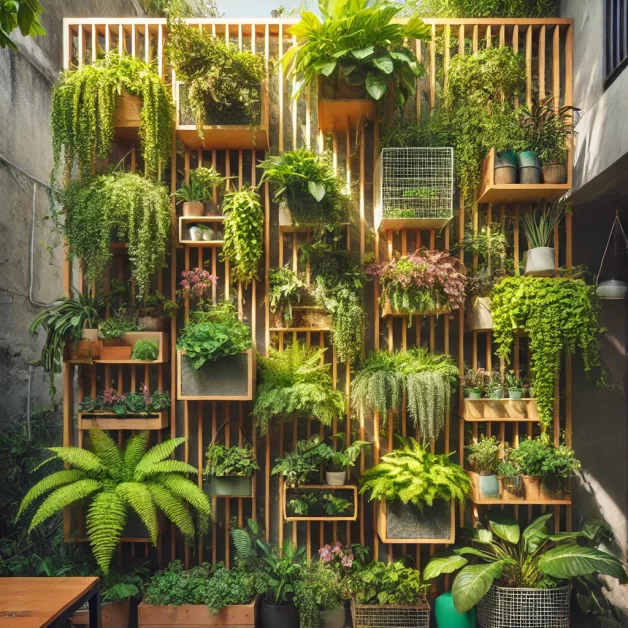
1. Vertical Gardens
Pallets or hanging pockets can also be used for growing herbs and small vegetables.
Perfect for small spaces like balconies or courtyards.
Use wall-mounted planters, shelves, or vertical structures to grow climbing plants like ivy or flowering vines.
2. Raised Garden Beds
They also allow for better control of soil quality and can be a stylish addition to your garden design.
Ideal for growing vegetables, flowers, or herbs.
Raised beds improve drainage, prevent soil compaction, and are easier to maintain, especially for those with mobility issues.
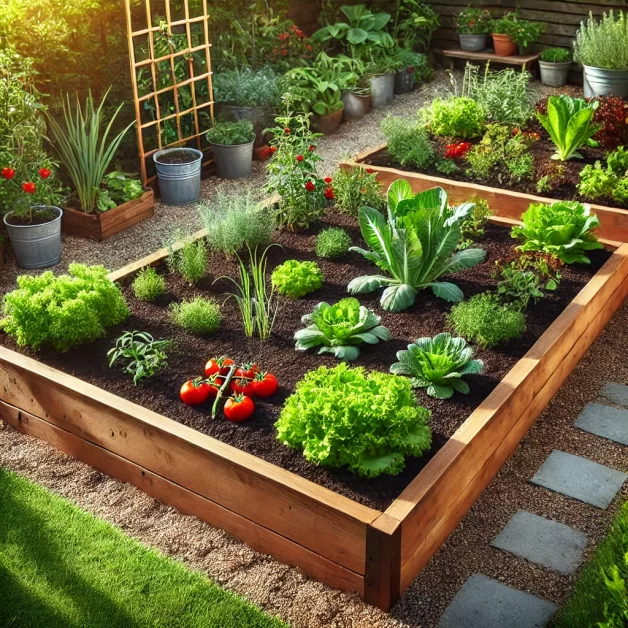
3. Container Gardening
Ideal for plants that don’t require deep soil, such as herbs, lettuce, tomatoes, or small fruit trees.
Great for patios, balconies, or spaces where you want to add flexibility.
You can use pots, buckets, or even creative containers like old wheelbarrows, bathtubs, or baskets.
4. Water Features
- Add a soothing element to your garden with a small pond, a water fountain, or a DIY birdbath.
- Water features attract birds, butterflies, and other wildlife, adding vibrancy and movement to your garden.
- Consider solar-powered fountains for an eco-friendly touch.
5. Themed Gardens
- Herb Garden: A dedicated section for growing herbs like basil, mint, thyme, and rosemary.
- Butterfly Garden: Grow plants like lavender, coneflowers, or milkweed to attract butterflies.
- Meditation Garden: Incorporate calming elements such as bamboo, zen-like stones, soft lighting, and quiet corners.
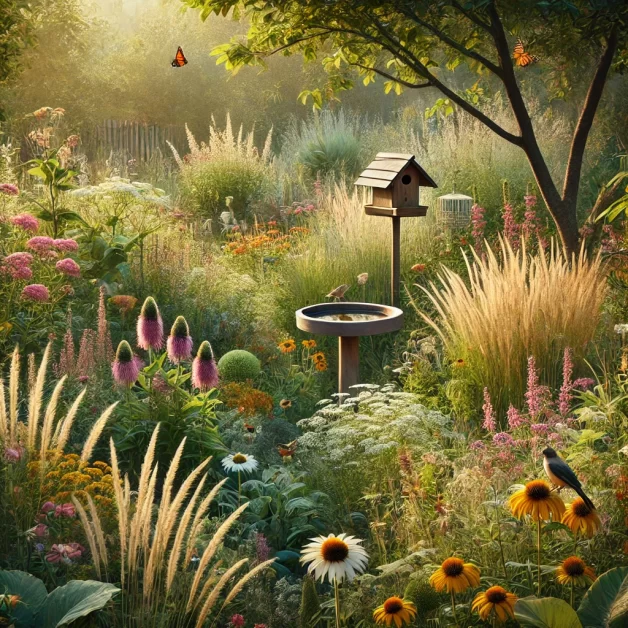
6. Wildlife-Friendly Garden
Leave some areas with natural ground cover and wildflowers for bees and other pollinators.
Plant native species to encourage local wildlife.
Install birdhouses, bee hotels, and butterfly feeders to create a thriving ecosystem.
7. Edible Gardens
- Combine ornamental plants with edible plants such as fruit trees, berry bushes, or vegetable patches.
- Companion planting, where certain vegetables or flowers grow together for mutual benefits (e.g., tomatoes and basil), can enhance garden productivity.
8. Pathways and Stone Walkways
- Add charm and structure to your garden with pathways made of stone, gravel, or brick.
- You can create meandering paths through flower beds, leading to a seating area or focal point.
9. Lighting Features
- Use solar-powered garden lights, string lights, or lanterns to illuminate your garden in the evening.
- You can highlight walkways, garden features, or trees to create a magical atmosphere.

10. Pergolas and Arbors
Pergolas can be draped with climbing plants like wisteria or grapevines, providing a romantic and practical space to sit and relax.
These structures can create shade and define spaces within your garden.
11. Rock Gardens
- Rock gardens mimic natural landscapes and are perfect for plants that thrive in dry conditions, such as succulents and alpine plants.
- Use rocks and gravel for a low-maintenance, drought-tolerant garden that still offers texture and interest.
12. Garden Seating Areas
- Add comfortable seating or a bench under a tree or next to a water feature to create a tranquil retreat.
- You can also use hammocks, outdoor sofas, or a small café-style table and chairs for dining al fresco.
13. Greenhouses or Mini Conservatories
- If you have the space, a greenhouse allows you to extend your growing season and grow plants that need more heat.
- Small, portable greenhouses can also help you grow vegetables and herbs year-round in colder climates.
14. Fairy Gardens
- Create a whimsical miniature garden using small plants, tiny houses, and fairy figurines.
- It can be incorporated into a corner of your garden or in containers and is especially fun for families with children.
15. Succulent and Cactus Garden
- Low-maintenance plants like succulents and cacti thrive in dry, sunny conditions and add an exotic look to your garden.
- These can be grown in pots or in designated rock beds.
16. Trellis and Climbing Plants
- Use trellises or archways for climbing roses, honeysuckle, or clematis to add vertical interest.
- These can also help create privacy if your garden is overlooked by neighboring houses.
Do you have a specific garden style or theme in mind you’d like to explore further?
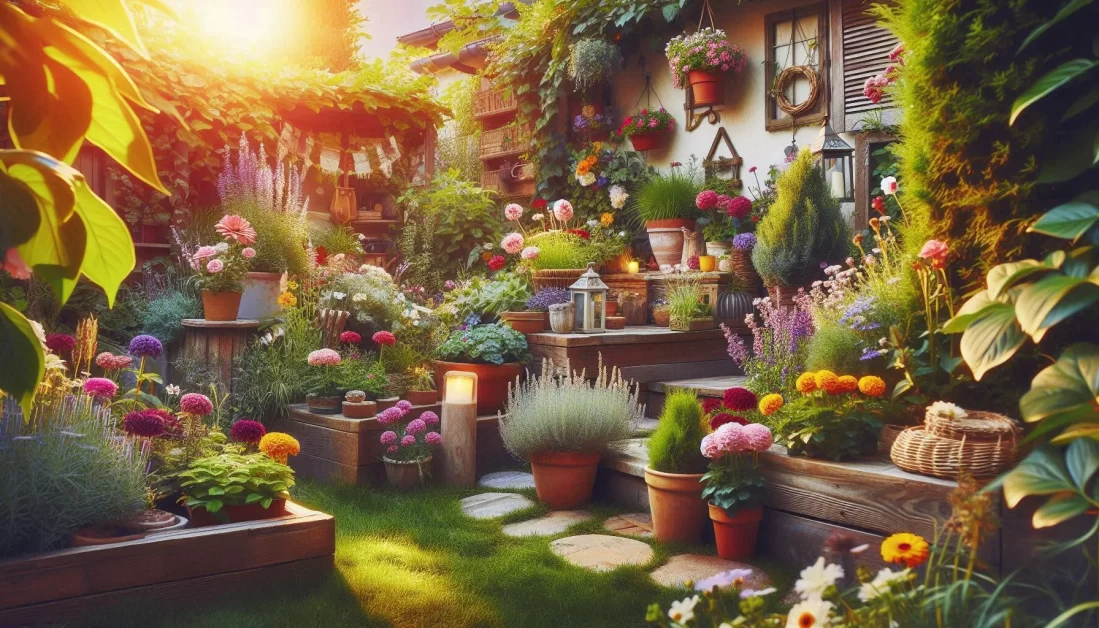
Small Garden Ideas
If you have a smaller garden, you can still create a stunning space with these design tips:
Catch the Eye with Vertical Gardens
- Utilize wall-mounted planters, hanging baskets, or trellises.
- Perfect for growing herbs, flowers, or vegetables in a compact area.
Expand Your Garden Space with Curves
- Add curved pathways or rounded garden beds to soften the look.
- Curves create a sense of space and add charm.
Frame a View to Create Depth
- Use a focal point like garden art, flowering shrubs, or water features.
- Frames draw the eye outward, making the garden feel larger.
Incorporate a Tiny Window Box Garden
- Fill with flowers, herbs, or small vegetables for a vibrant touch.
- Place window boxes on balconies, patios, or fences.
Garden Ideas for Home
Create a garden that mirrors your style and offers a relaxing space with these ideas:
- Brighten Your Garden with Colorful Furniture
- Add vibrant chairs, bold benches, or bright cushions.
- These elements make the space inviting and complement your plants.
- Add a Pergola for Shade and Style
- Install a pergola to create a defined outdoor area.
- Train climbing plants over it for natural shade and elegance.
- Use Geometrical Plants for a Formal Look
- Incorporate plants like boxwoods or trimmed hedges.
- Arrange them symmetrically for a classic and refined garden.
Garden Ideas on a Budget
Design a beautiful garden without overspending with these cost-effective tips:
- Reuse, Repurpose, Recycle Materials
- Transform old containers, pallets, or bricks into garden features.
- This approach saves money and adds a unique touch.
- Create DIY Raised Garden Beds
- Build raised beds from materials like old wood or cinder blocks.
- These are affordable, functional, and ideal for small spaces.
- Use Terra-Cotta Pots and Plant Markers
- Opt for durable terra-cotta pots for plants.
- Personalize them with paint and DIY markers for a decorative touch.
Container Garden Ideas
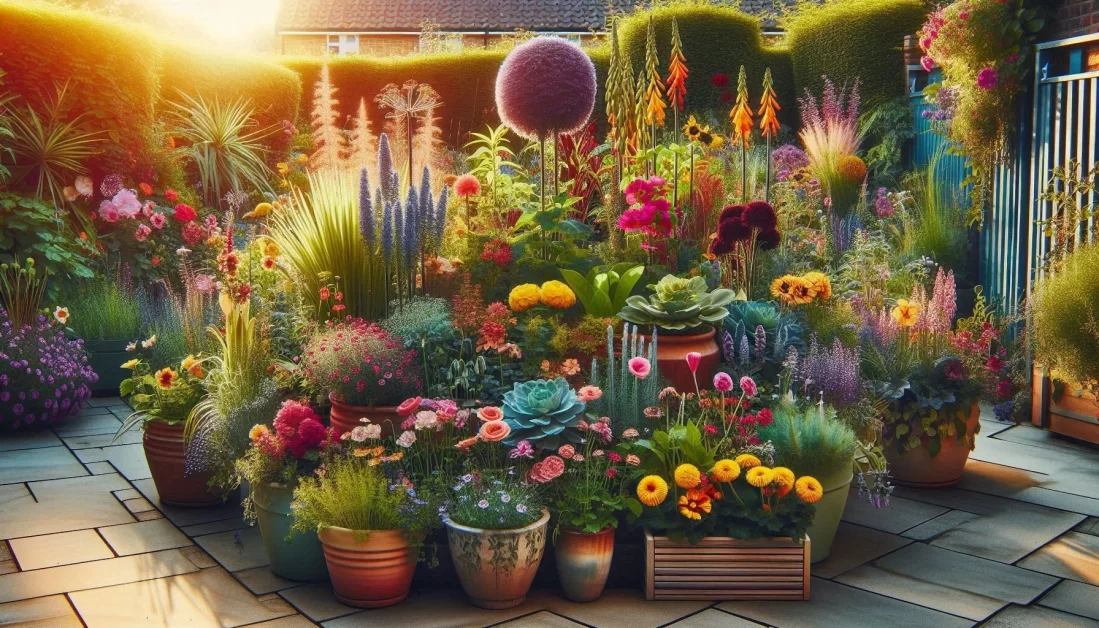
Container gardening provides a flexible, space-saving solution for adding greenery to any environment. Here are some ideas to make the most of your container garden:
- Create a Container Garden for Flexibility
- Move plants around to fit your space, whether it’s a balcony, patio, or windowsill.
- Ideal for experimenting with different plants and adjusting as seasons change.
- Use Double-Duty Containers for Space Efficiency
- Opt for containers that also serve as seating, storage, or decorations.
- A bench with built-in planters can provide both seating and space for flowers.
- Build Your Own Living Wall Garden
- Maximize vertical space by mounting containers on a wall or using a vertical gardening system.
- Fill with various plants to create a lush, space-saving green wall.
- Make Use of Hanging and Vertical Space
- Use hanging baskets and vertical planters to add more plants without occupying ground space.
- Perfect for trailing plants or growing herbs for easy access.
Potted Plant Ideas

Potted plants are a great way to add greenery to your home or garden, offering flexibility and ease of care. Here are some creative ways to use pots in your garden:
- Plant Potted Fruit Trees
- Choose dwarf or compact fruit trees that thrive in pots.
- Ideal for patios or small spaces, allowing you to enjoy fresh fruit right from your garden.
- Grow a Lattice Green Wall
- Arrange potted plants on a trellis or lattice to create a vertical green wall.
- Perfect for adding a lush backdrop to your garden or patio, and can include climbing plants or small flowers.
- Fill a Tray with Succulent Plants
- Arrange various succulents in a shallow tray for a stylish, low-maintenance display.
- Ideal for small spaces and provides an eye-catching arrangement with minimal care.
Shade Garden Ideas
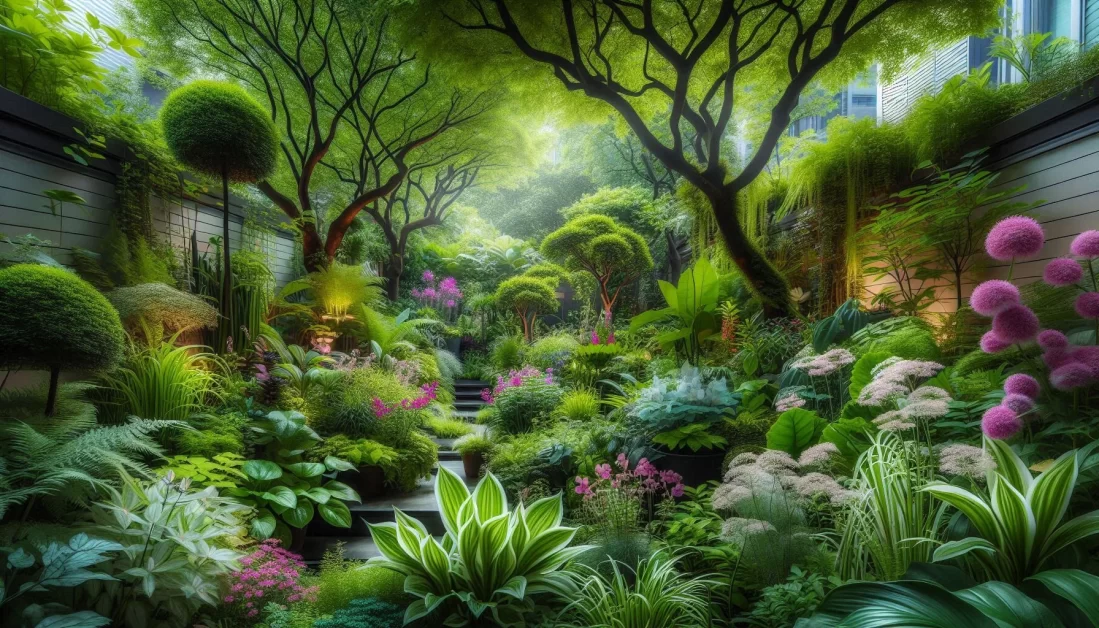
A shade garden can be a tranquil escape, even in low-light areas. Here are some ideas to transform your shaded space into a thriving, beautiful retreat:
- Choose Shade-Loving Plants
- Opt for plants like hostas, ferns, and astilbes that thrive in low light.
- Add shade-loving flowers such as impatiens or begonias for vibrant pops of color.
- Incorporate Varied Foliage for Texture
- Mix different leaf shapes, sizes, and colors to create visual interest.
- Combine broad-leafed hostas with feathery ferns for a rich, layered effect.
- Add a Water Feature for Tranquility
- Install small fountains or ponds to enhance the serene atmosphere with soothing sounds.
- Position the feature centrally or in a quiet corner to attract wildlife and provide a focal point.
- Use Ground Covers to Fill the Space
- Plant ground covers like ivy, periwinkle, or pachysandra to fill empty spaces and reduce weeds.
- These plants create a lush, green carpet and are low-maintenance, ideal for shade.
- Enhance with Garden Lighting
- Use soft, warm lights along pathways or around features to brighten your garden in the evening.
- Solar-powered lights are easy to install and eco-friendly, making your garden enjoyable after dark.
- Add Garden Art and Decor
- Incorporate sculptures, birdbaths, or benches to personalize your shade garden.
- Choose pieces that blend with the natural setting, such as stone statues or weathered wood, to enhance the garden’s peaceful vibe.
Flower Garden Ideas
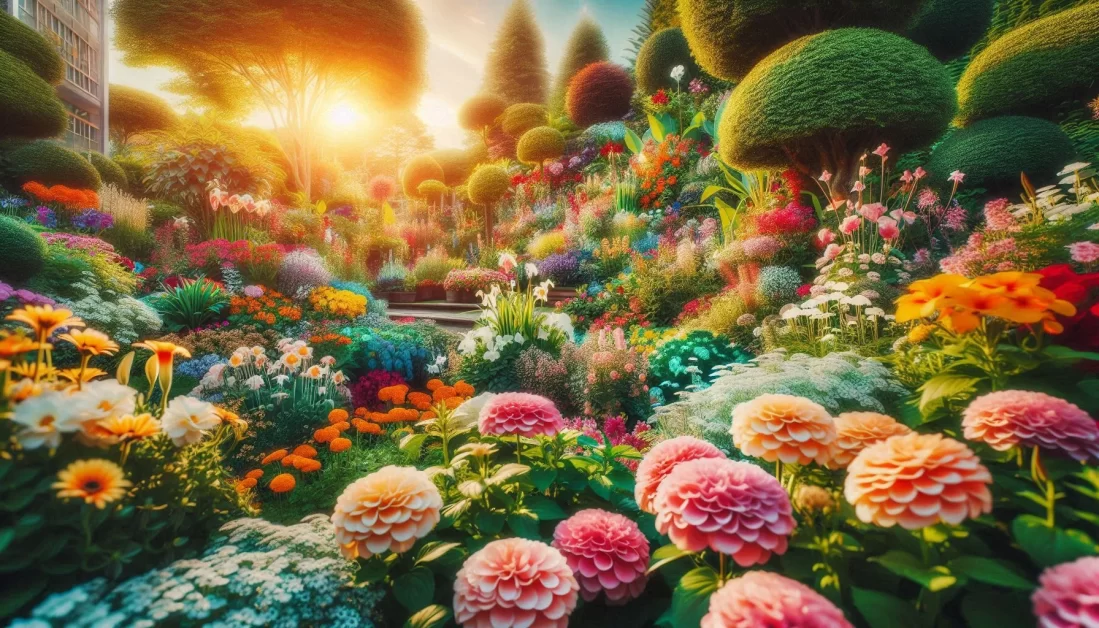
A flower garden enhances your outdoor space with vibrant colors, pleasant fragrances, and seasonal beauty. Whether you have a large yard or a small patio, these ideas will help you create a stunning flower garden that stands out and thrives throughout the year.
1. Start with a Flower Bed for Structure
- Choose a Location: Select a spot with appropriate sunlight for your chosen plants.
- Define Borders: Use edging materials like bricks, stones, or metal to keep soil and mulch in place.
- Design Layout: Decide between a formal, structured look or a more natural, flowing design.
2. Mix Perennials and Annuals for Continuous Blooms
- Perennials: Include plants that return year after year, such as daylilies, coneflowers, and peonies.
- Annuals: Add plants like petunias, marigolds, and zinnias for seasonal color.
- Combination: Mixing both ensures a garden that blooms from spring through fall.
3. Plant Fragrant Blooms for a Sensory Experience
- Fragrant Plants: Consider lavender, roses, and gardenias to add pleasing scents.
- Placement: Position aromatic flowers near seating areas or pathways to enjoy their fragrance.
4. Add Height with Trellises and Arbors
- Trellises: Use these to support climbing plants like clematis and morning glories.
- Arbors: Install arbors to create vertical interest and focal points.
- Training Plants: Train climbing plants to grow up these structures for added dimension.
5. Create a Pollinator-Friendly Garden
- Attract Pollinators: Choose flowers rich in nectar and pollen, such as sunflowers and echinacea.
- Plant Clusters: Group plants together to make your garden more attractive to bees, butterflies, and hummingbirds.
6. Design a Cottage-Inspired Flower Bed
- Mix of Flowers: Use a blend of flowers in soft, pastel colors combined with herbs and vegetables.
- Popular Plants: Consider foxgloves, hollyhocks, and delphiniums for a cottage garden feel.
- Informal Look: Aim for a slightly untamed, overflowing appearance.
7. Add Seasonal Interest with Bulbs
- Spring Bulbs: Plant tulips, daffodils, and hyacinths in the fall for early spring blooms.
- Summer and Fall Bulbs: Include lilies, dahlias, and alliums for later in the year.
- Staggered Planting: Choose a variety of bulbs to ensure a succession of blooms throughout the seasons.
DIY Garden Projects
Adding personal touches to your garden can make it uniquely yours. DIY projects are a great way to enhance your garden while showcasing your creativity and resourcefulness. Here are some ideas for DIY garden projects that can transform your space and provide a satisfying hands-on experience.
1. Build Your Own Raised Garden Beds
- Materials: Use wood, stone, or metal to construct your raised beds.
- Design: Choose the height and width based on your gardening needs and available space.
- Soil: Fill with high-quality soil and compost to ensure good drainage and nutrient levels.
2. Create a DIY Water Feature
- Fountain: Build a simple fountain using a large container, a water pump, and some decorative stones.
- Pond: Dig a small pond and line it with a pond liner; add aquatic plants and a small pump for circulation.
- Placement: Position your water feature in a central location to serve as a focal point in your garden.
3. Make a Vertical Garden
- Containers: Use wall-mounted pockets or repurposed materials like wooden pallets.
- Plants: Choose compact or climbing plants that will thrive in vertical spaces, such as herbs or small flowers.
- Mounting: Secure your vertical garden on a wall or fence to save space and add visual interest.
4. Construct a Garden Pathway
- Materials: Use stepping stones, gravel, or brick to create a pathway.
- Design: Plan a layout that guides visitors through your garden and highlights key areas.
- Installation: Level the ground and place your chosen materials to form a durable and attractive path.
5. Build a Simple Compost Bin
- Materials: Use wood pallets or chicken wire to create a basic compost bin.
- Setup: Construct a bin with enough ventilation and drainage to support composting.
- Maintenance: Regularly turn the compost and add kitchen scraps and yard waste to create nutrient-rich compost for your garden.
6. Craft Your Garden Planters
- Recycled Containers: Repurpose items like old boots, wooden crates, or tin cans as planters.
- Decorating: Paint or decorate containers to match your garden’s style.
- Drainage: Ensure each planter has drainage holes to prevent overwatering.
7. Install DIY Garden Lighting
- Solar Lights: Use solar-powered lights to illuminate pathways and garden features.
- DIY Lanterns: Create lanterns from mason jars or tin cans for a charming, homemade touch.
- Placement: Position lights to highlight key areas and create a cozy atmosphere in the evenings.
8. Create a Bird Feeder or Bird Bath
- Bird Feeder: Build a simple feeder from wood or repurpose a large bottle or teacup.
- Bird Bath: Use a shallow dish or bowl set on a pedestal to provide water for birds.
- Location: Place feeders and baths in quiet, sheltered spots to attract a variety of bird species.
Garden Design Tips
Designing a garden involves more than just planting flowers and vegetables; it’s about creating a space that reflects your style and meets your needs. These design tips will help you plan and execute a garden that’s both functional and beautiful.
1. Plan Your Garden Layout
- Sketch a Design: Start by drawing a basic layout of your garden space, including existing features like trees and paths.
- Define Zones: Create distinct areas for different purposes, such as a relaxation area, vegetable patch, or flower beds.
- Consider Scale: Ensure your design is proportionate to your garden size, avoiding overcrowding and allowing for easy maintenance.
2. Choose a Theme or Style
- Traditional: Opt for classic elements like formal flower beds, topiary, and neatly trimmed hedges.
- Modern: Incorporate clean lines, minimalist plantings, and contemporary materials like concrete or metal.
- Cottage: Embrace an informal look with overflowing flower beds, herbs, and a mix of colorful plants.
3. Incorporate Functional Features
- Seating Areas: Add benches, chairs, or a small table to create a space for relaxation and entertaining.
- Storage: Include garden sheds or storage solutions for tools and supplies to keep your garden organized.
- Paths and Walkways: Design pathways that connect different garden areas and provide easy access for maintenance.
4. Use Color and Texture Wisely
- Color Scheme: Choose a color palette that complements your home and garden. Use contrasting colors for visual interest and harmony.
- Textures: Mix different textures, such as smooth pebbles, rough bark, and soft foliage, to add depth and appeal.
- Seasonal Changes: Plan for color variations throughout the seasons with plants that bloom at different times of the year.
5. Consider Lighting and Ambiance
- Lighting: Install outdoor lighting to enhance the garden’s beauty and usability at night. Use solar lights or LED fixtures for energy efficiency.
- Ambiance: Create a relaxing atmosphere with garden features like water fountains, wind chimes, or decorative lanterns.
6. Focus on Sustainability
- Water Conservation: Use rain barrels, drip irrigation, or drought-tolerant plants to manage water usage efficiently.
- Eco-Friendly Materials: Choose sustainable materials for garden structures and avoid chemicals that can harm the environment.
- Wildlife-Friendly: Incorporate native plants, bird feeders, and pollinator-friendly flowers to support local wildlife.
7. Maintain Accessibility
- Paths and Accessibility: Ensure paths are wide and level to accommodate easy movement, especially if you have limited mobility.
- Raised Beds and Containers: Use raised beds or container gardens to reduce bending and make gardening more accessible.
- Maintenance Access: Design your garden layout to allow easy access for watering, weeding, and harvesting.
8. Personalize with Decorative Elements
- Garden Art: Add sculptures, garden gnomes, or other art pieces that reflect your personality and enhance the garden’s charm.
- Containers and Pots: Use colorful or uniquely shaped containers to display plants and add visual interest.
- Seasonal Decorations: Update decorations to match seasonal themes or holidays for a festive touch.
Seasonal Garden Tips
Gardening throughout the seasons requires adapting your approach to the changing weather and plant needs. Here are some seasonal tips to help you maintain a thriving garden year-round.
1. Spring Gardening Tips
- Plant Early: Start planting early-blooming flowers and cool-season vegetables as the weather warms up.
- Soil Preparation: Test and amend your soil with compost and organic matter to support healthy plant growth.
- Pruning: Trim back any dead or damaged branches from trees and shrubs to encourage new growth.
Prepare Your Soil for Planting
Test your soil with a soil test kit to check nutrient levels and pH balance. Amend the soil with compost or well-rotted manure to enrich it and improve drainage. Loosen the soil to improve aeration and root penetration.
Start Seeds Indoors
Begin sowing seeds indoors 6-8 weeks before the last expected frost. Use seed trays or pots with a seed-starting mix. Place seedlings under grow lights or in a sunny window to ensure strong growth.
2. Summer Gardening Tips
- Watering: Water plants deeply and consistently to prevent drought stress during hot weather.
- Mulching: Apply mulch around plants to retain moisture and regulate soil temperature.
- Pest Control: Monitor for pests and diseases, and use natural remedies or organic treatments to protect your plants.
Maintain Consistent Watering
Water early in the morning or late in the evening to minimize evaporation. Use soaker hoses or drip irrigation for efficient watering. Ensure the soil remains consistently moist but not waterlogged.
Harvest Regularly
Pick fruits and vegetables as they ripen to encourage continued production. Use clean, sharp tools to harvest and avoid damaging plants. Store harvested produce properly to extend its freshness and usability.
3. Autumn Gardening Tips
- Falling Leaves: Collect fallen leaves to use as mulch or compost.
- Planting: Plant fall bulbs like tulips and daffodils for a colorful spring display.
- Cleanup: Remove spent plants and debris to prepare your garden for winter.
Prepare Your Garden for Winter
Plant cover crops like clover or rye to protect and enrich the soil. Apply a layer of mulch around perennials to insulate roots and prevent frost damage. Clean and store garden tools and equipment properly for winter.
Prune and Trim
Prune back dead or diseased branches from shrubs and trees, and shape shrubs as needed. Cut back spent perennials and divide overgrown clumps to promote healthy growth in spring. Remove any diseased or pest-infested plant material to reduce the risk of issues next season.
4. Winter Gardening Tips
- Planning: Use the winter months to plan your garden for the upcoming year, including new plant varieties and layout changes.
- Indoor Gardening: Start an indoor herb garden or use grow lights to continue gardening indoors.
- Protection: Protect tender plants with frost covers or move pots to a sheltered location.
Plan for the Next Season
Sketch out garden plans and make a list of desired plants and improvements. Review seed catalogs and order seeds for spring planting. Learn about new gardening techniques and trends to try in your garden.
Indoor Gardening and Maintenance
Grow herbs like basil, parsley, and cilantro on a sunny windowsill or under grow lights. Care for houseplants by checking for pests and providing proper light and humidity. Clean and sharpen garden tools, and repair any damaged equipment.
Garden Ideas for Every Space and Style
Vertical Gardening:
- Perfect for small spaces: Vertical gardening is a great way to maximize space, especially in urban areas or on balconies. You can grow plants upwards instead of outwards using wall-mounted planters, shelves, or trellises.
- Various plants: You can grow plants in a vertical garden, including herbs, flowers, vegetables, and even small fruits. Choose plants that are well-suited to container growing and have shallow root systems.
- DIY options: There are many DIY options for creating vertical gardens. You can repurpose old items like pallets, ladders, or gutters or get creative with PVC pipes or chicken wire.
- Watering and drainage: One of the challenges of vertical gardening is watering and drainage. Make sure your planters have drainage holes, and consider using a self-watering system to keep your plants hydrated.
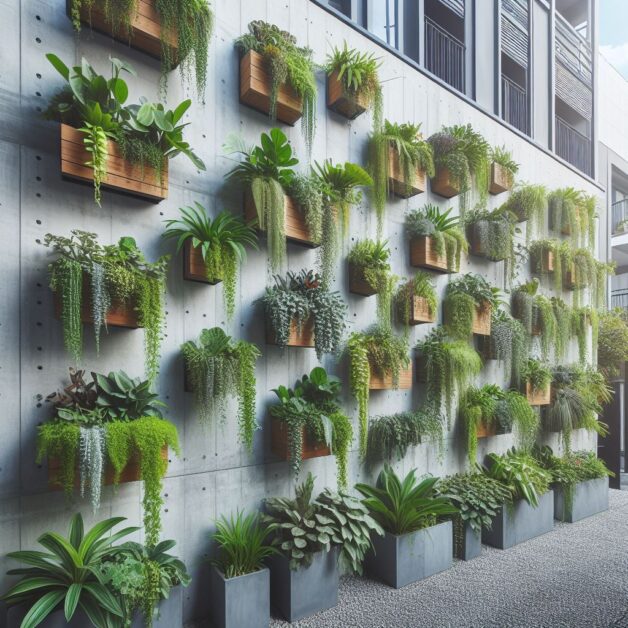
Pollinator Garden:
- Benefits: Pollinator gardens are not only beautiful but also play an essential role in the ecosystem. By providing food and habitat for pollinators such as bees, butterflies, and hummingbirds, you can help ensure the health of your local plants and crops.
- Native plants: Choose native plants that bloom at different times throughout the season to provide a continuous food source for pollinators. Some good options include coneflowers, milkweed, zinnias, and butterfly bushes.
- Design tips: Group plants with similar sun and water needs together, and use taller plants in the back and shorter plants in the front for visual interest. Consider adding stones, mulch, or a birdbath to your garden to provide additional habitat for pollinators.
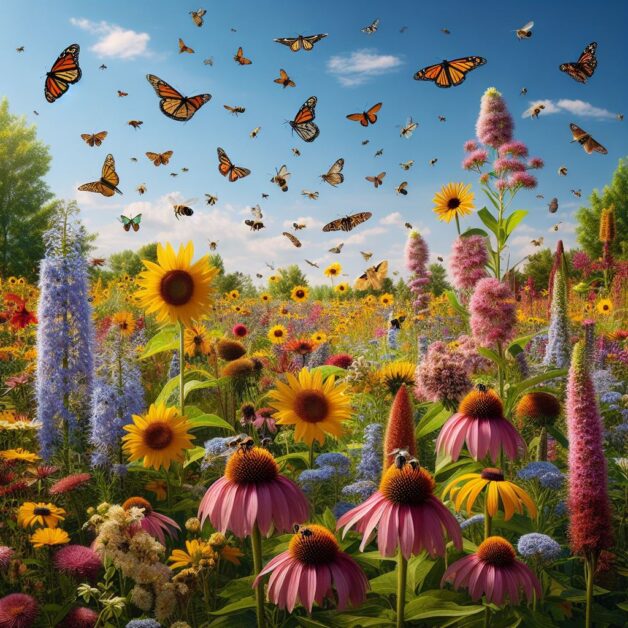
Zen Garden:
- Peaceful retreat: Zen gardens are designed to create a sense of peace and tranquillity. They typically use simple elements such as sand, stones, gravel, and carefully placed plants to create a minimalist and harmonious space.
- Symbolic elements: The elements in a Zen garden often have symbolic meaning. For example, sand represents water, stones represent mountains, and plants represent life.
- Maintenance: Zen gardens are relatively low-maintenance but require some upkeep. Regularly rake the sand, prune the plants, and replace any stones that have become out of place.
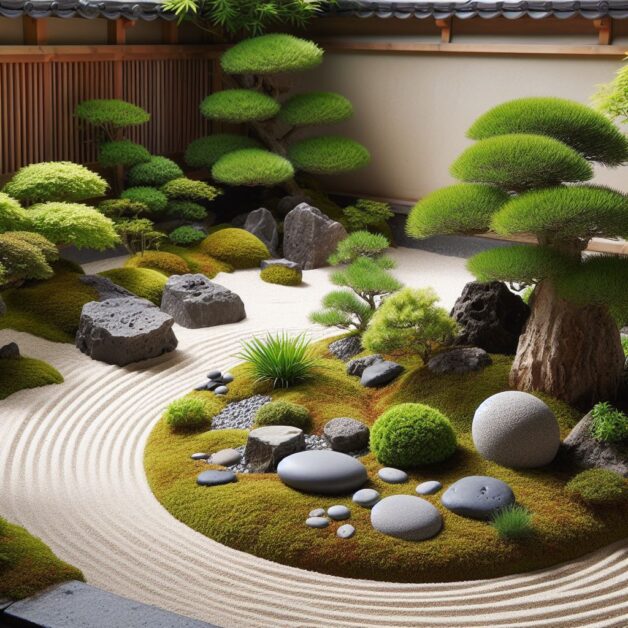
These are just a few ideas to get you started. You can create a beautiful and functional garden that meets your needs and interests with some creativity.
So, what will your garden be? A fragrant herb haven, a whimsical pollinator playground, or a meditative Zen oasis? The choice is yours! Grab your gloves, unleash your inner botanist, and start cultivating the green space of your dreams.
For more about outdoor relaxation & wellness, you can visit Hot Tub Patio. On the other hand, check out Garden and Patio to improve your outdoor space with landscaping and beautification.
Remember, even the most minor patch can blossom into a haven of beauty and joy.
Now, tell me, what’s your favorite type of garden? And what unique twist will you add to yours? Share your green thumb wisdom in the comments below! Check out for more about green gardening.







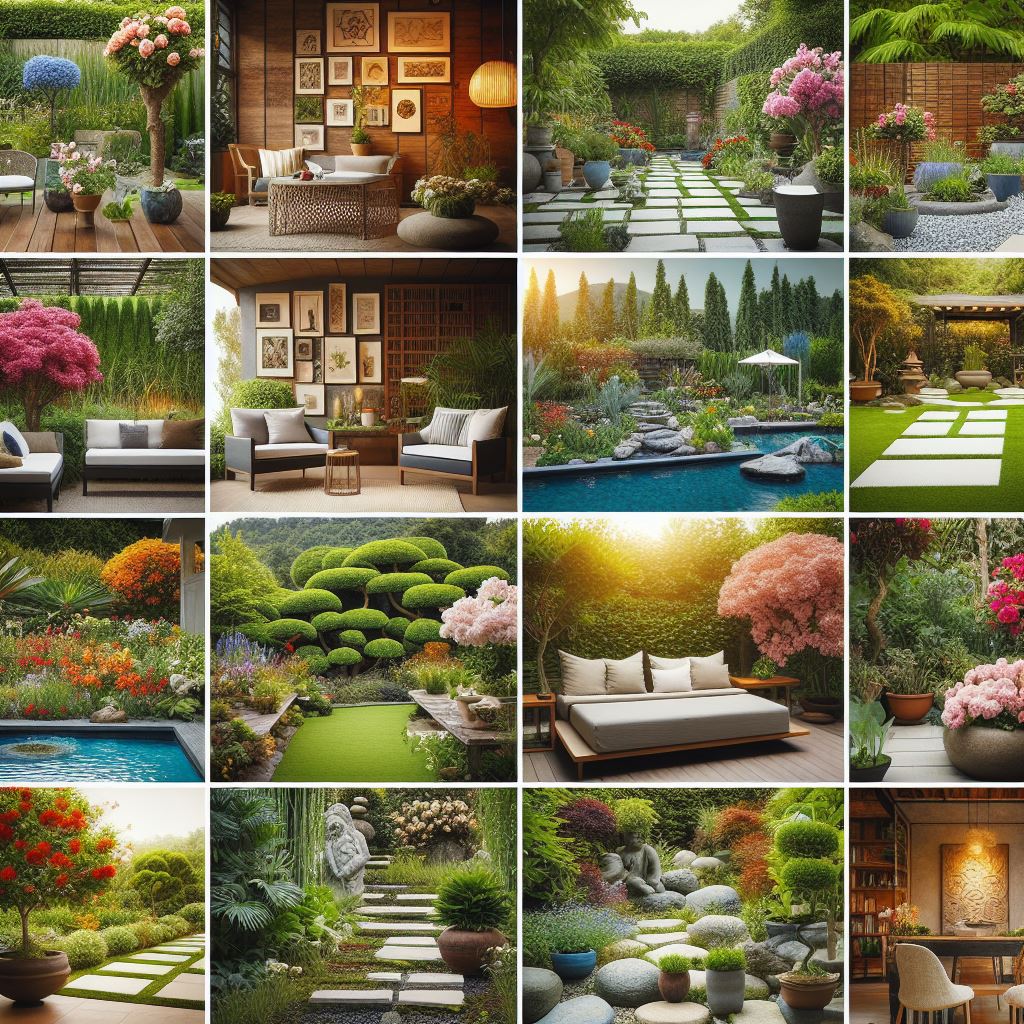





One Comment